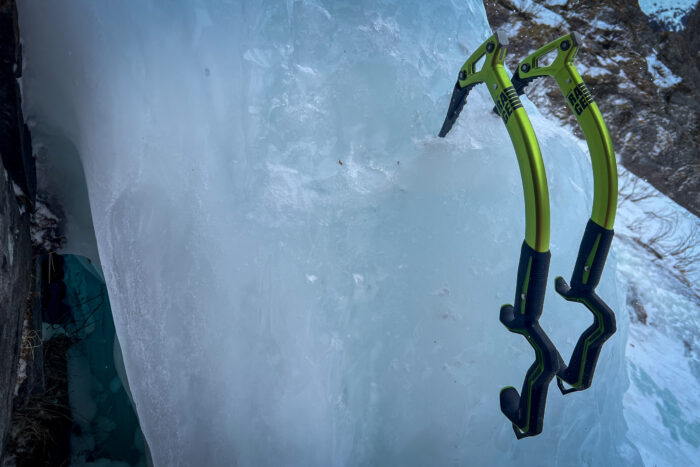After over ten years on the European market, the Edelrid Rage ice axe underwent a significant redesign. I had the opportunity to test the updated version, now available in the U.S., during a recent expedition to Alaska. The ice axes boast a striking green anodized finish and ergonomic handles that caught my eye.
However, aesthetics take a back seat when you’re high up on challenging terrain, battling fatigue and pushing your limits. Ice axes are essential tools that need to deliver consistent performance in demanding climbing situations. When it comes to ice climbing, reliability is key, especially when dealing with steep ascents.
Having a keen eye for how ice axes handle and perform, I evaluated the new Edelrid Rage as my team and I tackled frozen multipitch challenges in Alaska.
I put the Edelrid Rage ice axes to the test on 400- to 600-foot-high waterfall ice routes in remote areas around Palmer and Valdez over a week-long adventure in February. These routes pushed the limits of my ice climbing abilities. The icy conditions in Alaska during this season were particularly harsh, with temperatures ranging from 0 to just over 10 degrees.
In summary: Priced at $280, the Edelrid Rage ice axe performed like a sports car among a field of rugged SUVs. The tool excelled on steep and complex routes, with its weight, design, pick, and other features making it ideal for experienced climbers tackling challenging ascents. The axe truly shined on demanding terrain but felt a bit heavy on longer routes far from the trailhead.
-
Shaft material
Aluminum -
Grip material
TPU -
Available picks
Mixed, Ice -
Available accessories
Hammer, mini-hammer, adze -
Certification
EN 13089 Type 2
-
Optimal swing weight for hard ice -
Outstanding geometry and ergonomics for steep ice -
Exceptional grip adhesion -
Sturdy spike
-
Heavy for long approaches or very tall routes
Initial Thoughts on the Edelrid Rage

When I unpacked the Edelrid Rage ice axe, I noticed its weight, which felt heavier compared to other tools I’ve used for Alaskan ice climbing. Weighing in at 1 pound, 8 ounces with the mixed pick, head weight, and micro hammer included, it is notably heavier than the lightweight Trango Kestrel (1 pound, 3 ounces with head weight). However, its weight is similar to that of the Black Diamond Reactor, which weighs 1 pound, 6 ounces without a head weight or hammer.
The aggressive shaft geometry gave me confidence that the ice tool would perform well on WI5 routes and above. The angles of the shaft and TPU-coated ergonomic main grip appeared well-suited for vertical terrain and maneuvering around obstacles.
The handle stood out as exceptionally grippy, fitting my gloved hand perfectly. The pinky rest on both the main and secondary upper grips seemed spacious enough even for thick gloves. Though Edelrid includes plastic spacers to adjust the grip for smaller hands, I found them unnecessary.
Furthermore, the robust bottom spike was a thoughtful addition, as the clip-in hole can withstand up to 8 kN of force. This feature proves valuable if the Rage is used as an anchor.
Prior to my journey to Alaska, I switched out the standard mixed pick for an ice-specific one. Additionally, Edelrid offers larger hammer and adze options for the Rage.
Performance of the Edelrid Rage Ice Axe on Routes

Comfort and Efficiency of Grip and Swing Mechanics
Upon gripping the handles of the Edelrid Rage for the first time in Alaska, I couldn’t help but exclaim, “Ah, yeah!” The aggressively textured TPU material provided exceptional grip with my climbing gloves.
Besides offering a secure hold even in freezing temperatures, the handle’s diameter seemed perfect for my gloved hands, despite initial concerns from my climbing partners. I particularly liked that the secondary upper grip matched the aggressive textured pattern and size of the main grip.
Given the cold conditions before my trip, the ice was harder and more brittle than during my previous Alaskan expeditions. The Edelrid Rage pick, with added weights, had a more substantial swing feel compared to my other ice tools. However, it proved beneficial on the tough ice.
While the axes were heavier than most others I’ve used on backcountry adventures, they required less effort for swinging into hard ice. Although I burned a few extra calories on long approaches, the weightier design made it easier to penetrate the solid ice with each swing.

With each swing, the Edelrid Rage ice axe delivered reliable placements. I initiated force early, allowing the swing









